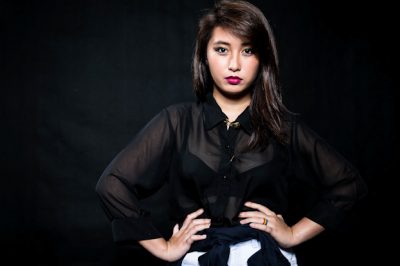There’s a reason people don’t walk around naked. From preppy polo-wearing jocks to lazily dressed video gamers, bowtie-touting dandies to A.P.C.-worshipping hipsters—even when a person doesn’t list fashion as one of his interests or priorities, clothes are an everyday necessity.
Wearing clothes, however, is only one leg of the race. Fashion design culminates in either an all-out runway show or even the simple idea of putting clothes on a person’s back, but it takes months and months of draping, embellishing, even acid dip-dyeing, to produce what will eventually be hanging in your closet.
“You don’t understand, this is Alaïa”
The Philippines’ fashion cycle is extremely different from the norm. Maybe it’s the two-season climate, maybe it’s the economic situation: either way, it’s a stark comparison. Fashion media and even the designers themselves take a backseat to the influence of celebrities and fashion bloggers, who are walking billboards for fast fashion.
Philippine Fashion Week is also lacking an influence on fashion trends. While Fashion Week has given younger designers the opportunity to get their names out there and clients in their studios, it also shows a deficiency in directional fashion.
In the September 2012 issue of local magazine Rogue, writer Gabbie Tatad questions why mass-market retail brands such as Penshoppe participate—“a rare practice in international Fashion Week counterparts.” Given that Fashion Week is supposed to be a point of confluence for true design concept and innovation, it becomes difficult for emerging fashion designers to develop their brands into something more than a bi-annual runway show.
Martin Yambao (AB EU ‘10) was also surprised to find that there isn’t much wiggle room for the new breed of designers. After a brief stint under family-owned accessories retailer Aranaz, Yambao has since become the brand manager of Rajo Laurel’s RajoMan. It was then that he learned putting clothes on a person’s back isn’t as straightforward as it sounds.
“The journey should be, you present a collection, buyers buy it, and then when you get big enough, you have your own store,” he shares. Here in the Philippines, the design direction is, mostly, made-to-order. And then if you’re big enough, you have your own store.
“Parang yun yung growth and yung direction, which is kind of weird. There are no high-end retailers [like Lane Crawford or Neiman Marcus] that would buy you and stock you in their store. I mean if there are, very little lang, mostly in consigners. It’s harder to survive.”
Expanding horizons
It doesn’t help that the industry is getting crowded. In between mass-market retailers like Bench and couturiers like Cary Santiago, there are a lot of local “brands” with ready-to-wear offerings manned by people who have no real background in fashion other than a burning interest for it.
Many of these people choose to work by imitating or altering existing designs, without having to go through the cycles of true fashion design, such as creating a pattern and fitting on a dress form or model—and yet they call themselves fashion designers. Because of this, there is a distorted perception of fashion, popular particularly with the youth: those who have had no real exposure to the fashion industry think it’s an easy job that anyone can do.
Management engineering senior Andy Wong shares that it took a Marketing and Law department class on Fashion Merchandising Management to completely comprehend the complexity of the fashion industry. While she enjoyed fashion as a consumer, “the industry itself to me, seemed intimidating and borderline untouchable,” she explains of her attitude toward fashion. “I had no family in the industry, no nitty gritty know-how, and no formal classes.”
From forecasting trends to dealing with inventory, visual merchandising to store layout, the class opened Wong’s eyes to how business and creativity must intersect in order to be successful in fashion.
The big leagues
Let’s compare and contrast. On one hand, there’s young fashion designer Martin Bautista (who many in the industry believe to be the next big name in local fashion design); on the other, there’s Interdisciplinary Studies junior Adi Amor and her line Aveadena.
Bautista details his creative process for a runway show. “I gather all my thoughts and inspiration and emotions and also in what direction [do] I wanna go with for a collection. And then, basically that’s where the challenge comes in.”
Bautista pauses to look at his hands, as if to imagine them sewing together a gown for his clientthe empowered womanbefore continuing, “Like yung inspiration, yung mga naiisip ko at yung mga gusto kong gawin (What I think of and what I want to do). The challenge is how to make it marketable to people, make it wearable, make it into a piece of garment that’s going to last for a while.”
This is where his preferred aesthetic shows. Bautista’s own minimalist approach goes hand in hand with what he wants for his clothes: longevity. “Parang, after twenty years, they could still wear it. And then of course, my team and I work on the collection, have fittings with the models and then on the day of the show of course it’s not easy. One day before the show we still edit,” he reveals.
Communication senior and Preview magazine intern Samantha Sadhwani is sympathetic. “I can’t even begin to imagine how tough a young designer’s journey is. There is so much that is requiredkeeping up with the daily trends, conjuring up numerous unique ideas, making seasonal collections, to name a few. It’s a really long and laborious process.”
Dipping your toes in
Amor, however, operates on a completely different level. She buys cloth, then sits down with a seamstress to discuss what she wants. “I sketch it, and then I tell her I want a detail here or there, and she’ll make it happen,” Amor explains. “Sometimes I get the actual cloth and I show her how I want it [to] fall. Or because I don’t know the terms for it, I have to show them a picture.”
After a loose version of it is completed—Amor estimates roughly 80%—they meet again for Amor to check if the seamstress understood her vision. The next time they meet, Amor will have in her hands any number of pieces, at whatever measurements she specified.
This also lends some insight on labor in the Philippines: many people get clothes made by seamstresses for next to nothing, when in other countries, such skill level would demand a higher price point, especially given that these brands are supposedly able to compete on the same level as real fashion designers.
This divide in such an important dimension of fashion design is telling. “Gucci keeps it in Italy. [It’s about] craftsmanship talaga. It’s found where you are, kasi you control it,” Yambao points out. “Especially the more high-end you go. Keep it at home because that’s what you’re selling: the craft, the quality. Though the retail aspect talaga, you can’t beat China. You can buy a finished dress [there], wala pa yung labor dito (labor isn’t even paid for here). That’s insane.”
A call to arms
Bautista lends a democratic voice to the definition of fashion design. He brushes aside technical skill or a fashion school pedigree in favor of the translation of emotion. “I consider a person a designer if the clothes have soul. If they have depth—and not just simply clothes,” he emphasizes, in a mix of English and Filipino. “Real designers are the ones who make clothes a person can really wear. Real clothes should be like a language everyone could understand. For me, that’s the real designer.”
Getting clothes made won’t make you an industry leader, though it’s a step in the right direction. While there is nothing wrong with a can-do approach toward fashion, one must give credit where it’s due. As seen in 2006’s The Devil Wears Prada, a multi-billion dollar industry doesn’t become one for nothing.
After all, everyone wears clothes.
Modeling: Jenny Lapus, Ruth Rivera, Ariel de Leon, and Arianna del Rosario
Hair and makeup: Sylvina Lopez
Styling: Elisa Aquino and Chiara Garcia
Shorts courtesy of: Peregrine by Patricia Lafiguera
- Photos by Ryan Y. Racca and Miguel R. Santiago



















































